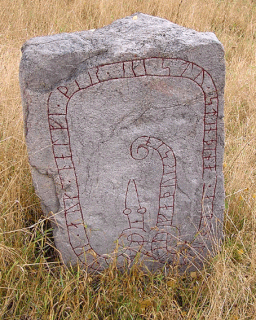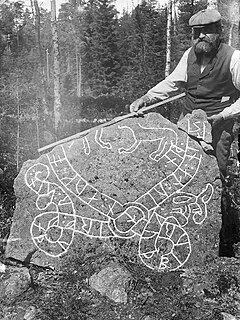
Uppland Runic Inscription 77 is the Rundata catalog number for a Viking Age memorial runestone that is located at Råsta, which is in Sundbyberg Municipality, Stockholm County, Sweden, which is in the historic province of Uppland.

The Lingsberg Runestones are two 11th century runestones, listed as U 240 and U 241 in the Rundata catalog, and one fragment, U 242, that are engraved in Old Norse using the younger futhark and located at the farm at Lingsberg, which is about 2 kilometres (1.2 mi) east of Vallentuna, which is about 24 kilometres (15 mi) north of the center of Stockholm, Stockholm County, Sweden, which was part of the former province of Uppland.

The Viking runestones are runestones that mention Scandinavians who participated in Viking expeditions. This article treats the runestone that refer to people who took part in voyages abroad, in western Europe, and stones that mention men who were Viking warriors and/or died while travelling in the West. However, it is likely that all of them do not mention men who took part in pillaging. The inscriptions were all engraved in Old Norse with the Younger Futhark. The runestones are unevenly distributed in Scandinavia: Denmark has 250 runestones, Norway has 50 while Iceland has none. Sweden have as many as between 1,700 and 2,500 depending on definition. The Swedish district of Uppland has the highest concentration with as many as 1,196 inscriptions in stone, whereas Södermanland is second with 391

Sö 194 is the Rundata designation for a runic inscription on a memorial runestone located in Brössike, which is about 12 kilometers northeast of Strängnäs, Södermanland County, Sweden, which was in the historic province of Södermanland. There are many such memorial runestones in Scandinavia. While the tradition of carving inscriptions into boulders began in the 4th century and lasted into the 12th century, most runestones date from the late Viking Age.

Södermanland Runic Inscription 84 or Sö 84 is the Rundata designation for a runic inscription on a Viking Age memorial runestone located in Tumbo, Södermanland County, Sweden, and in the historic province of Södermanland.

The Stenkvista runestone, designated as runic inscription Sö 111 in the Rundata catalog, is a memorial runestone located near the church at Stenkvista, which is two kilometers east of Skogstorp, Södermanland County, Sweden, which was formerly part of the historic Södermanland, and which features a depiction of Thor's hammer, Mjöllnir. This runestone is one of several runestones in Scandinavia that has a dedication to Thor. While the tradition of carving inscriptions into boulders began in the 4th century and lasted into the 12th century, most runestones in Scandinavia date from the late Viking Age.

This runic inscription, designated as U 839 in the Rundata catalog, is on a Viking Age memorial runestone located in Ryda kungsgård, which is about 6 kilometers north of Enköping, Uppsala County, Sweden, and in the historic province of Uppland.

The Lovö Runestones are five Viking Age memorial runestones that are located outside the Lovö church on the island of Lovön in Lake Mälaren, which is in Stockholm County, Sweden, and in the historic province of Uppland.

The Gamla Turingevägen Inscriptions are two Viking Age memorial runic inscriptions and one image that are designated as Sö 311, Sö 312, and Sö 313 in the Rundata catalog, that are located in Södertälje, Stockholm County, Sweden, and in the historic province of Södermanland.

Sö 328 is the Rundata catalog number for a runic inscription on a Viking Age memorial runestone which is located in Tynäs, which is about one kilometer east of Strängnäs, Södermanland County, Sweden, which is in the historic province of Södermanland.

This runic inscription, designated as U Fv1976;104 in the Rundata catalog, is on a Viking Age memorial runestone that is located at the Uppsala Cathedral, Uppland, Sweden.

The Björklinge runestones are five Viking Age memorial runestones designated in the Rundata catalog as U 1045, U 1046, U 1047, U 1048, and U 1050 that are located at the church in Björklinge, Uppsala County, Sweden, which is in the historic province of Uppland. In addition, there is a small fragment of a runestone with a partial runic text i * lit * rita * meaning "had erected" that has been given the catalog number U 1049.

Uppland Runic Inscription 1146 or U 1146 is the Rundata catalog designation for a Viking Age memorial runestone that is located in Gillberga, which is about 1 kilometer east of Tierp, Uppsala County, Sweden, which is in the historic province of Uppland.

Sö 292 is the Rundata catalog number for a Viking Age memorial runestone located in Bröta, which is about six kilometers southwest of Väländan, Stockholm County, Sweden, in the historic province of Södermanland.

Sö 298 is the Rundata catalog number for a Viking Age memorial runestone located in Uringe Malm, which is about four kilometers west of Väländan, Stockholm County, Sweden, in the historic province of Södermanland.

Södermanland Runic Inscription 178 or Sö 178 is the Rundata catalog number for a Viking Age memorial runestone which is located at Gripsholm Castle, Södermanland County, Sweden, which is in the historic province of Södermanland.

The Kyrkogården Runestones are three Viking Age memorial runestones located at the cemetery of St. Mary's Church in Sigtuna, Stockholm County, Sweden, in the historic province of Uppland. One of the runic inscriptions documents the existence of a Viking Age mercantile guild in Sweden.

Södermanland Runic Inscription 226 or Sö 226 is the Rundata catalog listing for a Viking Age memorial runestone located in Norra Stutby, which is about eight kilometers north of Sorunda, Stockholm County, Sweden, which was in the historic province of Södermanland.

Södermanland Runic Inscription 235 or Sö 235 is the Rundata listing for a Viking Age memorial runestone fragment that is located in Västerby, which is six kilometers southwest of Väländan, Stockholm County, Sweden, and in the historic province of Södermanland.

The Vidbo Runestones are two Viking Age memorial runestones that are located in the churchyard of the Vidbo church, which is about ten kilometers east of Knivsta, Uppsala County, Sweden, in the historic province of Uppland.





























